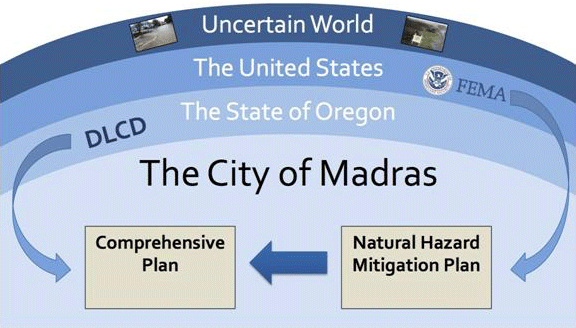
In my hometown on the southern coast of North Carolina, preparing our home for natural disasters, namely hurricanes, was part of the routine. The first storms I remember were Bertha and Fran in the summer of 1996. Both hurricanes made landfall near my hometown within a few weeks of one another. Our house was undamaged that summer, but I can still remember standing on our front porch in the eerily calm eye of the storm, knowing we were only halfway through.
My personal experience with natural disasters piqued my interest in this year’s Community Planning Workshop (CPW) project that focuses on Natural Hazard Mitigation Planning in the City of Madras. After 18 years on the coast of North Carolina, I was very familiar with how to prepare for an imminent storm event, but I had always considered the extent of damage nearly inevitable. It had not occurred to me that it was within our power to reduce the impacts natural hazards have on our communities.
In other words, I didn’t know about natural hazard mitigation.
Mitigation refers to the things we can do now to reduce the impacts of a natural hazard in the future. It is the sustained preparations that we take when a hazard event is not imminent to make our communities more resilient when the inevitable happens.
Now, Oregon certainly isn’t at risk from hurricanes, but other hazard events, such as floods, wildfires, and the recent snow and ice storms do threaten the safety of Oregon’s residents on a regular basis. Earthquakes, tsunamis and volcanoes also pose serious, albeit less frequent, risks.
The OPDR – Oregon Partnership for Disaster Resilience is one of four programs within the Community Service Center. Among other things, this program helps Oregon cities plan with a mitigation mindset. One strategy they use is to help cities create Natural Hazard Mitigation Plans (NHMPs). Cities and other jurisdictions use NHMPs to identify and prioritize specific actions they can take to better prepare themselves for the natural hazards described above.
Last year, a CPW-Community Planning Workshop team developed an NHMP for Jefferson County, which includes the City of Madras in Central Oregon. This year, we’re taking that project a step further by incorporating the goals and priorities in the NHMP into the City of Madras Comprehensive Plan.
The graphic (shown above) depicts the policy framework of this project. We created this graphic to help illustrate the complicated interconnections of federal, state, and local policies as they relate to local planning for natural hazards. Our project is essentially that blue arrow pointing to the left. The NHMP and Comprehensive plans already exist, but we’re taking the relevant parts of the NHMP and crafting an addition to a comprehensive plan chapter so Madras will be able to better prepare itself for natural hazards.
This step, integrating the NHMP into the comprehensive plan, helps the city incorporate mitigation planning into their long-term land-use planning goals. It also provides an opportunity to develop public support of these projects. However, very few cities in the country have thoroughly addressed hazard mitigation in their comprehensive plans, so figuring out the best way to integrate these plans in Madras is part of the challenge.
That’s why this project is so important. For one, integrating the NHMP and comprehensive plan will help the City of Madras be more prepared for hazard events. Additionally, this project will serve as an example to other cities throughout the state and country that want to undertake a similar project. In fact, creating a lessons-learned case study that other towns can use to guide their own plan integration process is one of our project deliverables.
By the end of our project we will have seen the integration process of writing a comprehensive plan chapter through from start to finish for the City of Madras. Just as importantly, our process will be able to serve as a guide for other Oregon cities to build a safer, more resilient futures.
 About the Author: Laura Stroud grew up dodging hurricanes in the town of Jacksonville on NC’s southern coast. She graduated from the University of North Carolina at Chapel Hill with a degree in Geography before moving to the Blue Ridge Mountains to serve an AmeriCorps term at a land conservancy. Laura hit the AmeriCorps jackpot a second time with Resource Assistance for Rural Environments (RARE) when she served with a community development organization in Roseburg, Oregon. Laura is a first-year Community and Regional Planning graduate student at the University of Oregon.
About the Author: Laura Stroud grew up dodging hurricanes in the town of Jacksonville on NC’s southern coast. She graduated from the University of North Carolina at Chapel Hill with a degree in Geography before moving to the Blue Ridge Mountains to serve an AmeriCorps term at a land conservancy. Laura hit the AmeriCorps jackpot a second time with Resource Assistance for Rural Environments (RARE) when she served with a community development organization in Roseburg, Oregon. Laura is a first-year Community and Regional Planning graduate student at the University of Oregon.
